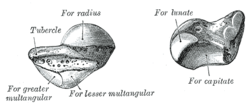- Scaphoid bone
-
Bone: scaphoid bone Shown is the right hand, palm down (left) and palm up (right).
Proximal: A=Scaphoid, B=Lunate, C=Triquetral, D=Pisiform
Distal: E=Trapezium, F=Trapezoid, G=Capitate, H=Hamate
1= Radius, 2=Ulna, 3=MetacarpalsThe left scaphoid bone Latin os scaphoideum, os naviculare manus Gray's subject #54 221 Articulations articulates with five bones
radius proximally
trapezoid bone and trapezium bone distally
capitate and lunate mediallyMeSH Scaphoid+Bone The scaphoid bone is one of the carpal bones of the wrist. It is situated between the hand and forearm on the thumb-side of the wrist (also called the lateral or radial side). The scaphoid bone is the largest bone of the proximal row of wrist bones, its long axis being from above downward, lateralward, and forward. It is approximately the size and shape of a medium sized cashew.
Contents
Gallery
Etymology
The etymology of the scaphoid bone is derived from the Greek skaphe which means "a boat," and the Greek eidos which means "form".[1] This refers to the shape of the bone, supposedly reminiscent of a boat, and in older literature on human anatomy[2] the scaphoid is referred to as the navicular bone of the hand, since there is also a bone in a similar position in the foot, called the navicular. In reptiles, birds, and amphibians, this bone is instead commonly referred to as the radiale, because of its articulation with the radius.
Surfaces
The superior surface is convex, smooth, of triangular shape, and articulates with the lower end of the radius.
The inferior surface, directed downward, backward and laterally is also smooth, convex, and triangular, and is divided by a slight ridge into two parts, the lateral articulating with the greater multangular, the medial with the lesser multangular.
On the dorsal surface is a narrow, rough groove, which runs the entire length of the bone, and serves for the attachment of ligaments.
The volar surface is concave above, and elevated at its lower and lateral part into a rounded projection, the tubercle, which is directed forward and gives attachment to the transverse carpal ligament and sometimes origin to a few fibers of the Abductor pollicis brevis.
The lateral surface is rough and narrow, and gives attachment to the radial collateral ligament of the wrist.
The medial surface presents two articular facets; of these, the superior or smaller is flattened of semilunar form, and articulates with the lunate bone; the inferior or larger is concave, forming with the lunate a concavity for the head of the capitate bone.
The distal convex surface articulates with trapezium and trapezoid.[2]
Clinical significance
The scaphoid can be slow to heal because of the limited circulation to the bone. It receives its blood supply primarily from lateral and distal branches of the radial artery. Fortunately, it is relatively difficult to break, but is the most commonly fractured bone in the carpus, particularly because of its unique anatomy and position within the wrist. Approximately 60% of carpal fractures are scaphoid fractures.
The scaphoid primarily receives its blood from the distal end. Failure to heal of the fracture ( non union ) will lead to post traumatic osteoarthritis of the carpus. Healing of the fracture with a non anatomic deformity ( frequently a volar flexed "humpback" ) can also lead to post traumatic arthritis . Non unions can result in loss of blood supply to the proximal pole which can result in avascular necrosis of the proximal segment.
A condition called scapholunate instability can occur when the scapholunate ligament (connecting the scaphoid to the lunate bone) and other surrounding ligaments are disrupted.
Fractures of the scaphoid must be recognized and treated quickly, as prompt treatment by immobilization or surgical fixation increases the likelihood of healing in anatomic alignment avoiding mal union or non union. Delays may compromise healing. Even rapidly immobilized fractures may require surgical treatment, including use of a headless compression screw such as the Herbert screw to bind the two halves together.
Palpation
The scaphoid can be palpated at the base of the anatomical snuff box. It can also be palpated in the volar (palmar) hand/wrist. Its position is the intersections of the long axes of the four fingers while in a fist, or the base of the thenar eminence. When felt in this position, the bone will feel to slide forward during radial deviation (wrist abduction), and flexion.
Clicking of the scaphoid, or no anterior translation can indicate scapholunate instability.
See also
- Bone terminology
- Terms for anatomical location
- Preiser disease
- Scaphoid fracture
- Watson's test
References
- ^ Mosby’s Medical, Nursing and Allied Health Dictionary, Fourth Edition, Mosby-Year Book 1994, p. 1396
- ^ a b "Gray's Anatomy, 6b. The Hand. 1. The Carpus. 4". 1918. http://www.bartleby.com/107/54.html. Retrieved December 2009.
External links
- SCAPHOID FRACTURES - FAQ
- sports/85 at eMedicine - Navicular Fracture
Bones of upper limbs (TA A02.4, GA 2.200–230) Pectoral girdle,
clavicleScapula fossae (subscapular, supraspinatous, infraspinatous) · scapular notch · glenoid cavity
tubercles (infraglenoid, supraglenoid) · spine of scapula · acromion · coracoid process
borders (superior, lateral/axillary, medial/vertebral) · angles (superior, inferior, lateral)Humerus upper extremity: necks (anatomical, surgical) · tubercles (greater, lesser) · intertubercular sulcus
body: radial sulcus · deltoid tuberosity
lower extremity: capitulum · trochlea · epicondyles (lateral, medial) · supracondylar ridges (lateral, medial) · fossae (radial, coronoid, olecranon)Forearm Hand carpus: scaphoid · lunate · triquetral · pisiform · trapezium · trapezoid · capitate · hamate (hamulus)
metacarpus: 1st metacarpal · 2nd · 3rd · 4th · 5th
phalanges of the hand: proximal · intermediate · distalCategories:- Bones of the upper limb
- Skeletal system
- Wrist
Wikimedia Foundation. 2010.





